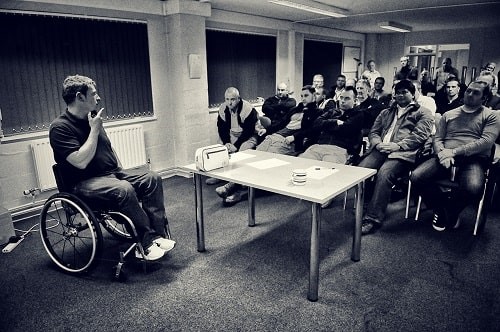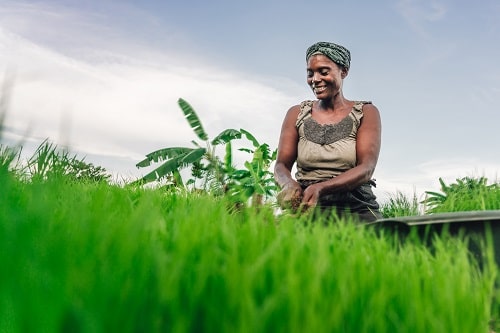Almost 30 years ago, I was descending a ladder when my life changed with devastating consequences.
Features
Let’s make work at height safer
On 3 January 1993, I was involved in a totally avoidable accident on a construction site while working as a roofing labourer for my father-in-law’s roofing company.
I was not a roofer by trade, but it was the time of the 1990s recession and work had been hard to find after I’d been made redundant from my previous job as a skilled signwriter.
January 3rd was also the first day back after the Christmas break and it was a cold, foggy, icy day – just the kind of day you really didn’t want to be on a construction site. However, the day passed by like any other, but at around 2.30pm a rush job came along, setting off a train of events that was to change my life forever with devastating consequences.
We were asked to look at a leaking roof on another part of the project that was causing issues for other trades on the site. After inspecting this unplanned piece of work, my boss explained it would take at least two hours to repair. We were asked if we could get it done in one due to the failing daylight.
My boss climbed the ladder but I initially hesitated to follow him up. The ground conditions were terrible, the ladder wasn’t tied on and it was unsafe. However, I chose to ignore my gut instinct and didn’t speak up about it being unsafe. I got safely onto the roof, we got the job done but it was when I was coming down off the job the accident happened.
The ladder was being footed by another worker and I descended to the bottom rung. Thinking I was down and the job finished, the guy footing the ladder moved away, but I was called back up to retrieve some tools. As I got about halfway back down, the ladder slipped and I fell. Initially, I thought I was ok. I was very winded, but as I tried to sit up, I became aware I couldn’t feel my legs.
An ambulance was finally called (there were no mobile phones in those days), and the paramedics suspected I had suffered a spinal injury. Eventually, they took the decision to move me and I was taken to hospital in Nottingham. Initially, after an X-ray I was told I was suffering from a condition called spinal shock as a result of the fall and the effects of the paralysis would be temporary.
However, after going for a CT scan, just to make sure, I was given the devastating news that I had suffered a fracture to vertebra T10. I’d suffered massive spinal injuries and was very frankly told that I would never walk again and would spend the rest of my life confined to a wheelchair.
Although I had heard the doctor say those words to me I didn’t believe him. These things always happen to other people, right? You see on television and in the movies where people are told things like this and they always recover – and I was going to be that person. However, after a major operation that involved metal rods and screws being inserted into my back, I was transferred to a spinal rehabilitation hospital in Sheffield, 50 miles away from where I lived.
Just 24 years old
I was just 24 years’ old, married with two young children – my daughter Abbi was three years old and my son Sam was just seven months old – and the impact was huge. I spent months at the rehabilitation hospital learning all the skills you would need to spend the rest of your life in a wheelchair. I think coming to terms with the fact I would be doubly incontinent, potentially impotent and would have difficulty having more children was harder to deal with than not walking.
 Today, Jason is proud to work with organisations like the Ladder Association, PASMA and IPAF to spread the safety message. Photograph: iStock
Today, Jason is proud to work with organisations like the Ladder Association, PASMA and IPAF to spread the safety message. Photograph: iStock
After being discharged from hospital, my young marriage quickly broke down. In fact, my wife left with my children just one day after I came out of hospital.
I felt unable to speak to anyone – whether it be family, friends or medical staff – about how I was really feeling, and I started using alcohol as a way of coping. However, things soon escalated, and I started taking recreational drugs, mainly ecstasy and speed (amphetamine). This cycle of abuse only ended when I suffered a serious reaction to taking ecstasy in January 1995. This resulted in me being put into an induced coma and placed on a life support machine.
My parents were told I had probably suffered irreparable brain damage and I would need 24-hour care. On day 15, they were advised to turn my life support off, but my Dad refused. On day 17, I opened my eyes but would spend nearly five months – longer than my original accident – in hospital recovering from the devastating effect the drugs overdose had wreaked on my body.
I felt so ashamed of what I had done and knew that I had to find a way of coping. Although I was still drinking too much I never touched drugs again. I was still desperately unhappy but now I had to focus on bringing my two children up, as they had come back to live with me full time. Around this time, I also discovered disabled water-skiing and that gave me something small to focus on – it was an activity I could do that didn’t involve my wheelchair. It was great as I was now seeing other people with disabilities, my children could be involved and it was keeping me fit and out of the pub, although there was a drinking culture after the end of the skiing day.
Depression and anxiety
However, I was still secretly battling severe feelings of depression and anxiety, and this would last for over a quarter of a century. The catalyst for change in my life and how I felt and coped day-to-day only came when I started to speak for the first time about my accident as a public speaker and workplace safety trainer, many years afterwards. In fact, it is only in the past three to four years that I have started to bring wellbeing and gratitude into my daily life, and can now say I’m finally thriving in life again.
I finally received some compensation for my accident in 2007 after a 14-year battle. I spent a good chunk of my compensation just trying to enjoy myself, and I honestly had no direction or purpose in my life, apart from raising my two children who were living with me full time.
However, a chance meeting at the end of 2008 with a guy called Dan Terry, a behavioural safety professional, literally changed the whole direction of my life. He listened to the story of my accident, the impact on my life and the impact on my family and friends and offered to coach me so I could share my story with workers, managers and directors in industry, to help prevent this happening to someone else.
Dan took me to watch him work as a safety speaker and trainer and I honestly thought ‘I can’t do this’ and I explained it wasn’t for me. However, some time later Dan contacted me again and took me to a different project where he was delivering training. Halfway through the session where he would normally show a safety impact video he put me on the spot and asked me to share my story live to the audience. This was the start of my speaking career, though at this point I was still very nervous and hesitant about sharing my life and the full details of the accident and its impact on me with complete strangers.
Then, at a small training event a guy in the room was very obviously not listening to my presentation. To this day I do not know what came over me but I just sat there and told him everything about my story and at the end he came up to me and said “I get it now, thank you”.
In that moment I realised that if by sharing my story I could prevent this happening to just one person then it was worthwhile putting myself through the anguish of repeating what had happened to me. When I talk about my accident to an audience, the emotion is as raw and strong as the day of the incident and when I was first told I was paralysed. I think this raw emotion grabs the attention of even the most hardened workers in a way a normal safety briefing can’t; because it actually shows what happens if you don’t follow the safety rules.
Impact on my family
The impact of what happened to me on my family and friends was huge and it is still the hardest part of my accident I must deal with, especially the impact on my parents. My parents not only had to deal with the immediate impact of my accident – including me spending months in hospital and being told I would never walk again – they then had to watch their son’s life disintegrate in front of their eyes while feeling there was nothing they could do to help.
When I tell my story to an industry audience, I think the biggest impact is not my accident itself and the impact on my life but the impact it has had on my parents, family and friends. One of my oldest friends Sean Toon regularly speaks alongside me during my presentation about the impact my accident had on my group of friends, something people do not usually hear.
The impact on my friends of both the accident and how my life and behaviour changed for the worse in the years afterwards was huge, and left them not knowing what they should say or do. Although I was unaware at the time, in the years I was abusing alcohol and drugs one of my friends would be the nominated chaperone to made sure I was okay when we went out and to make sure I got home safely. Sometimes they would go out without me, mainly because my behaviour at the time was horrendous. But they would then feel guilty when they got home knowing that I had been left at home. So, the accident didn’t just affect me – it affected them too.
Football had been such a massive part of my life – following Nottingham Forest as a normal fan and having a normal fun football day out with friends. Today, I still go to watch my beloved Forest, but the whole football experience is different and two of us always have to go and watch in the disabled area and not as all friends together.
Falling from a ladder
Another really impactful part of my presentation is when I tell people how high I fell. I intentionally leave this out at the start of my presentation, and when I tell them it was from just 10 feet you can feel their reaction. The fact I was paralysed in a fall from just 10 feet high in my opinion shows there is no safe working at height ever – if you don’t take the right precautions and fail to always use the correct equipment. However, we can make work at height as safe as possible by always choosing and using the correct equipment and following all the safety rules and procedures.
Obviously, huge strides have been made in recent years to make working at height a lot safer. I am amazed at the advancements in equipment and machinery that are available today to keep people safe at height. However, I think it’s crucial that workers are adequately trained to use the new safety equipment and machinery and it’s even more crucial they then choose to use it in the way that they have been instructed to. I do believe that some people think that the presence of machinery and equipment means they don’t have to think about safety, but it’s crucial that they do. Working at height is still responsible for a significant number of injuries and deaths each year.
I think attitudes to working at height have improved over the years, and I’m proud to work with organisations like the Ladder Association, PASMA and IPAF to spread the safety message, and I’m also an ambassador for the No Falls Foundation charity. But I’m still shocked at some of the accidents I get to hear about and the injuries and fatalities that are still being caused by people choosing to work unsafely at height. Indeed, social media is full of such photos.
I believe we need to continue to educate everyone – from directors to workers – about the dangers of unsafe work at height. But we also need to share success stories to reinforce the message that while there will always be an inherent risk, it is possible to carry out work at height in a safe way.
We obviously must keep focusing on how to work safely at height. But I also feel we have to look at the overall health and wellbeing of our workers and co-workers because if someone is having a bad day at work for whatever reason – whether it be stress, personal problems or something else – this can lead them to work unsafely at height, for example, by taking short-cuts.
I’m going to continue giving my health and safety talks, even though it’s harrowing for me to relive what happened to me. I want to change behaviours; change the mindset of people to work safely; and I want to make a difference to others.
I’d say to anyone reading and hearing my story: do not become a fall from height statistic; for the sake of yourself, your family and your friends.
Contact Jason Anker MBE at: www.ankerandmarsh.com
Proud 2b safe: www.p2bs.org
[email protected]
0845 269 5175
FEATURES

Why quality data is essential when using AI for occupational safety and health management
By Dr Bob Rajan-Sithamparanadarajah. Safety Groups UK (SGUK) on 01 April 2025
Artificial intelligence-powered models, systems and technology have the potential to significantly improve the management of occupational safety and health (OSH) risks, but it is vital that OSH practitioners understand the limitations and dangers of using AI to protect people at work.

Sustainable aviation fuels: how do we put the SAFety in SAF?
By Megan Hine, Draeger Safety UK on 01 April 2025
Sustainable aviation fuel is seen as having great potential to reduce the greenhouse gas emissions from air transportation. However, as with other emerging renewable energy sources, the safety risks arising from the production, processing and storage of these biofuels can be accompanied by new risks and will require careful management from the safety industry as utilisation increases to meet the Government’s mandatory targets.

Why social sustainability should be a priority for health, safety, environmental and compliance professionals
By Agnes Chruszcz, IEMA (Institute of Environmental Management and Assessment) on 01 April 2025
By embedding social sustainability principles into their policies and operations, organisations can not only improve quality of life for their employees, workers in their supply chains and the communities they interact with, but boost their business resilience, productivity and reputation.



